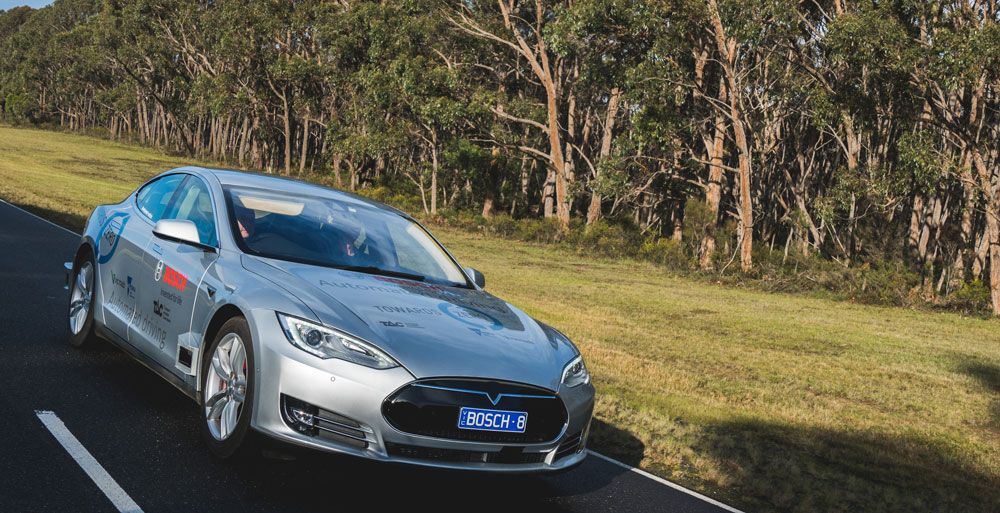CAV Highway Pilot Trial on Victorian Rural Roads

The Victorian Department of Transport and Transport Accident Commission partnered with Bosch (Australia) to trial a highly automated driving system and connectivity features on Victorian rural roads. A donor vehicle was modified to integrate the prototype system and tested in real world conditions on regional roads.
Many trials have focused on low speed shuttles, urban environments, or higher speed urban motorways. Regional rural roads present unique challenges for an automated driving system. This trial focused on high speed, high volume rural roads - where nearly half of all Victorian road fatalities occur.
With over 32 TB of development data captured and 3,000 kms of operation in Automated Driving mode, this was the largest CAV trial conducted in Australia to date. The results confirmed the potential contribution of this technology to road safety in the Victorian rural road environment, generating insights for future investment and planning (infrastructure, roads, communications and technology requirements) in order to reduce road trauma.
Start and end dates: September 2018 - December 2020
Lead organisation: Bosch Australia
Location: Melbourne and regional Victoria, Australia
Additional organisations: Department of Transport (Victoria), Transport Accident Commission (TAC)
Project budget, funding sources, components or breakdown of cost: A $2.25 million grant was provided as part of the Towards Zero Road Safety CAV Trial grants program
Contact person: James Soo (Manager Safer Vehicles and Future Vehicle Technology, DoT Victoria)
Link to project website: CAV Highway Pilot trial on Victorian rural roads
Included technologies
- Automated driving and driver support: highly automated driving
Project stages
- Testing for specific performance
Included locations
- Rural motorways and divided highways
- Rural main highways
Benefits directly sought by the project
- Increase knowledge and experience of the technology
- Commercial return - product / service development
Project scale
- Two vehicles - one fitted with Bosch's prototype automated driving system, and a second vehicle equipped for the collection of data necessary to generate high definition mapping content.
- Three trial locations on a selection of Victorian rural highways.
- Over 32 TB of development data captured, and 3,000 km in automated driving mode.
Further details on included technologies
The Bosch prototype automated driving system comprises a highly networked combination of LiDAR, radar and camera sensors, connectivity features, GPS and high performance computing. The technology employed is capable of actively monitoring its environment with a 360 degree field of perception, and maintaining accurate on-road localisation in environments with varying feature densities. In combination with advanced behavioural planning capability, it allows for automated multilane driving functionality under real-world traffic conditions.
Objectives
Development and trial of highly automated driving systems on Victorian rural highways, in order to ascertain the road safety benefits and infrastructure requirements to enable this technology to be deployed on Victoria's road network.
Research questions that the project aims to address
- Can automated vehicle technology function on Victorian rural roads and deliver significant road safety benefits?
- What are the road infrastructure design and maintenance requirements to enable CAV technologies?
- What characteristics of Victorian regional road environments require further technology developments?
Lessons learned to inform the conduct of trials
- Real-world trials expose the automated vehicle to conditions particular to that environment, including traffic, highway infrastructure, and topography.
- HD mapping is a critical component for automated driving trials. Currently there is no standard for HD maps or ready availability of HD maps for Victorian roads. Any trial needs to consider where its HD maps will be sourced.
- Strong and continued collaboration between industry and government agencies is required to facilitate automated driving technology in Australia, as most issues can be addressed either through dedicated technological developments or through changes to infrastructure, although most often it will require a combination of both.
- There is no image library representative of the Australian road environment suitable for machine learning purposes.
Lessons learned that inform future technology deployments
- Automated driving technology could be adapted to work within the Victorian rural environment.
- Regional roads have a relative scarcity of roadside features and lack of environmental information that an automated driving system processes to operate.
- Radar landmark-based localisation (a mapping layer created from radar data) was able to compensate in situations where inputs from camera-based landmarks and differential GNSS were degraded or unavailable.
- Up-to-date information (either crowd-sourced or provided by road managers) will assist in deciding which roads should be considered as part of the initial Operational Design Domain for automated vehicles, particularly with respect to the following aspects:
- Design and geometry of the road network (e.g. minimum curvatures, lane widths, emergency lane availability)
- State of road infrastructure and maintenance requirements (e.g. barriers, markings, roadside environment)
- Access restrictions and authorised road users
- Hazard locations and Accident statistics.
Benefit assessment of the tested technologies
- Along the extended, featureless highway sections commonly found in regional Victoria, a Highway Pilot function demonstrated capability to provide the attention and focus required to drive safely for long distances. This task can be challenging for human drivers and is one contributor to the elevated risk of serious injury and death in driving on rural roads. The system’s capability to monitor other road users continuously, combined with a defensive driving style and compliance with traffic rules and speed limits demonstrated a foundation for a low-risk driving decision-making approach.
Link to any other supporting project reports
Last updated: May 2021.
